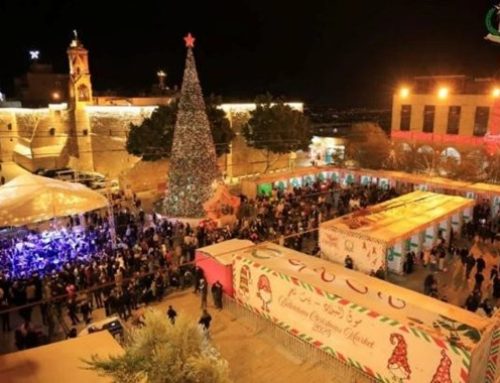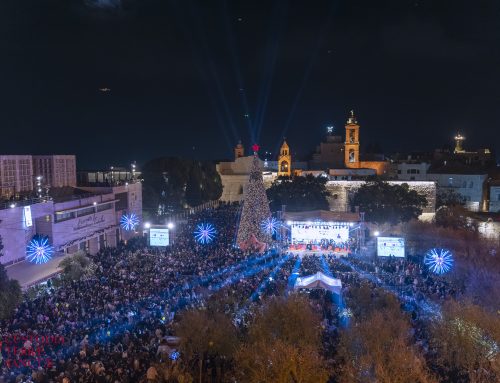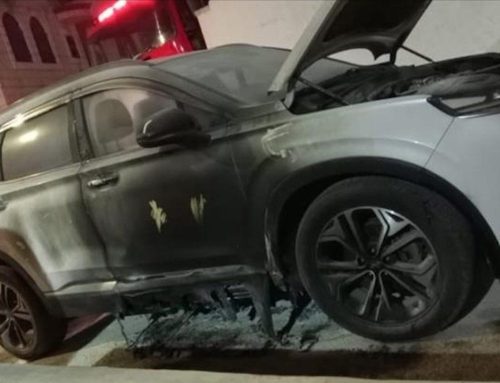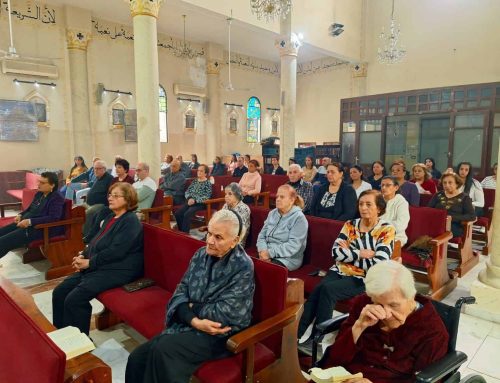(United States’ relations with the Middle East are highly volatile at the time of this writing in early December and this analysis and advocacy guide could be overtaken by events of either war against Iraq or terrorist action.)
December 2002
(United States’ relations with the Middle East are highly volatile at the time of this writing in early December and this analysis and advocacy guide could be overtaken by events of either war against Iraq or terrorist action.)
Whatever one might say about the U.S. coddling of Israel, its policy has been consistent in “stating” its opposition to Israel’s relentless and continuous building of settlements in the occupied territories. Now we hope it’s a time when the Administration will finally do something about it.
Why now, when all aspects of Middle East peacemaking appear bleak, if not destroyed, by the spiraling violence?
First, the Bush Administration is gearing up to finalize, at a December 20th meeting, a new peace plan in conjunction with what is termed “the Quartet” – i.e., the United Nations, European Union and Russia.
Second, the turmoil in Israeli politics has brought into the spotlight the newly elected Labor party leader Amram Mitzna, who favors dismantling Jewish settlements in the territories.
Third, Israel asked the President, on November 25, for a massive influx of new military aid, plus up to $10 billion in loan guarantees to boost its slogging economy.
The Administration could calculate that pressing Israel on settlements at this time is likely to bring diplomatic benefit with a minimum of flack from Israel’s supporters.
ROAD MAP OR DEAD END?
In spite of ongoing Israeli-Palestinian violence and Iraq war preparations, the Administration is hosting a meeting on December 20 of its three partners (U.N., EU and Russia) in the Quartet, to continue working on a “road map” that leads to an independent Palestinian state. U.S. diplomats have busily shopped a draft to all the parties, as well as to Jordan, Egypt and Saudi Arabia.
The President, in his June 24 speech in the Rose Garden, sketched a route to the vision he articulated of two states living side-by-side in peace and security by 2005. Even as he berated Palestinian leadership and violence, he called for “an end to the Israeli occupation that began in 1967” and explicitly insisted “that Israeli settlement activity in the occupied territories must stop, consistent with the recommendations of the Mitchell Committee.”
Now 18 months following the Mitchell Committee report, former Senator George Mitchell, in a Brooking Institute conference titled “Defining the Road Map,” spoke of the strong support that the United States has given Israel since its founding, and of some differences.
“Prominent among those differences is the U.S. government’s long-standing opposition to the government of Israel’s policies and practices regarding settlement. As then Secretary of State James Baker said in 1991, ‘I don’t think there is any bigger obstacle to peace than the settlement activity that continues not only unabated, but at an enhanced pace.’ The policy described by Secretary Baker on behalf of the administration of President George H.W. Bush has been, in essence, the policy of every American administration over the past quarter-century – of Jimmy Carter to George W. Bush. The circumstances in the region are much changed from those which existed 20 years ago, yet President Reagan’s words of September 1, 1982, remain relevant. He said, and I quote, ‘The immediate adoption of a settlements freeze by Israel, more than any other action could create the necessary confidence.'”
But “immediate” timing may prove as elusive as it was 20 years ago. Haaretz, an Israeli newspaper, on November 26, reported that the U.S. wants the freeze to go into effect after a general cease-fire, while the other members of the Quartet want to see it go into effect immediately to spur a Palestinian cease-fire.
IT’S THE ECONOMY, STUPID
The shopworn adage of American politics was reborn in Israel in October and precipitated the collapse of the Likud/Labor coalition government. Labor’s walkout came about in dispute (seen as a pretext by some) with the budget proposed by P.M. Sharon that included an additional 700 million NIS (about $150 million dollars) for settlements. The Labor party contended that budget needs for social services and infrastructure within the 1967 green line should be the priority. According to reports from the Israel Policy Forum, this was the first time that the Israeli majority’s view on settlements made a difference within the unity cabinet. According to the Dahaf poll in late October, and other surveys of Israelis, not only do most Israelis not want to spend more on settlements, most (78 percent) are ready to “dismantle” them in the context of peace negotiations.
And that’s the view of the man who will stand against Sharon in the January 28 elections. Amran Mitzna promised during his primary campaign that he would divert funds from settlements to development projects in Israel’s Arab communities. Although the predictions are that he will lose to Sharon’s Likud party, Mitzna’s campaign will awaken hope for peacemaking among both Israelis and Palestinians. The mayor of Haifa and an ex-general, Mitzna was elected leader of the Labor party in a landslide following the breakup of the coalition. He is in favor of Israeli withdrawal from the West Bank and Gaza, dismantling Jewish settlements in the territories and opening the way to an independent Palestinian state.
BILLIONS IN LOAN GUARANTEES
Even though Israel’s per capita GDP is larger than Spain’s, it is the largest recipient of U.S. loans and grants. Israel’s total is $2.9 billion this fiscal year. Nevertheless, Israel is requesting an additional $8-$10 billion in loan guarantees to bolster its economy. This action would underwrite Israeli loans from commercial banks at lower rates.
It was 11 years ago that the first President Bush received a similar request to finance resettlement of Soviet Jews. Ariel Sharon, then Israel’s infrastructure minister, was the main champion of settlements at that time. The elder Bush and his Secretary of State Baker linked the loan guarantees to demands for a freeze on West Bank settlements and were angered by opposing pressure from pro-Israel groups. That show- down was a factor in the defeat of Yitzhak Shamir as prime minister and the election of Yitzhak Rabin and his Labor party in 1992.
This request, along with the expected request from Israel for an additional $2-$4 billion in military aid, will be a focus of lobbying in 2003 by pro-Israel organizations, including the powerful American Israel Public Affairs Committee (AIPAC). It is predicted that the military aid bonus for Israel will be bundled with aid packages for Jordan and Turkey, along with other costs and incentives related to a war against Iraq in a bill that will easily pass Congress.
But the loan guarantee request is another matter. This presents an opportunity for the Administration to take a more evenhanded stance in pressing both Israel and Palestinians to break the cycle of violence and move toward a negotiated solution.
The precedent set by the President in 1991 would be an appropriate policy action for the President in 2003 as well. The broad congressional and U.S. public support for Israel’s security, even among Jewish Americans, does not extend to settlements and settlers.
WHAT’S THE PROBLEM?
The term “settlements” is used broadly to describe the colonial outposts that Israel has built on land it conquered in 1967-the Gaza Strip and the West Bank including East Jerusalem-which is referred to as the Occupied Territories. The settlements are considered illegal by international law: the Fourth Geneva Convention prohibits a government from transferring its civilian population to territory it occupies or from undertaking permanent changes. Israel does not recognize the applicability of the Fourth Geneva Convention.
The settler population of Israeli Jews in the West Bank is about 380,000, including 180,000 who live in East Jerusalem. The 140 settlements in the West Bank vary widely, from full-blown cities to enclaves of a few trailers and a generator. In Gaza, 6,700 settlers live in 17 settlements. The future of settlements was to be determined in the final status negotiations outlined in the Oslo Accords, and new settlement construction was criticized by the United States as prejudging this final status issue. Nevertheless, settlements continued to expand throughout the Oslo Process, doubling in size between 1993 and 2000. Additionally, a network of “bypass” roads (actually wide highways) were built, requiring even more confiscation of Palestinian land, for the exclusive use of Israelis.
Palestinians watched this settlement activity with dismay as their leadership negotiated with Israel the terms of fulfilling the “land for peace” premise of U.N. Security Council Resolution 242. It seemed obvious that Israel intended to segregate the Palestinians in non-contiguous enclaves, separated by settlements and bypass roads, and surrounded by Israeli military forces. Could such a “Swiss-cheese” state, many asked, be either viable or independent?
It is, however, at the human level where the most bitter fruit of settlements is found. B’tselem, an Israeli human rights monitoring organization, recorded more than 1,000 incidents of settler hooliganism and vigilante action since the start of this fall’s olive harvest. The November 29th issue of the Forward gives one example, witnessed by Yanoun’s Mukhtar (village leader.) “Like clockwork, the settlers spilled out from between the ancient olive groves on Saturday evenings this fall and raided the village, burning its generator, sacking its irrigation system and sniping at villagers trying to harvest this year’s olive crop.” The top rabbi in the religious Zionist camp, Mordechai Eliyahu, was reported in The Jerusalem Post to proclaim that “Jews have the right to pick the olives from the groves of the Palestinians” since they were growing on land that God promised to the Jews.
In response to the Palestinian killing of a dozen Israeli settlers and soldiers in Hebron in November, Sharon proposed uprooting more Palestinians to create a corridor linking the Tomb of the Patriarchs to Jewish enclaves in Hebron and Kiryat Arba – the large settlement bordering Hebron. Along that route, the Kiryat Arba Council has already announced a plan to build 1,000 housing units for settlers.
LAND FOR PEACE
For decades the U.S. churches that are members of CMEP have called for an end to settlement building as an essential step to end the occupation and resolve the conflict. In 1980 an ecumenical policy statement on the Middle East noted that the settlement policy in the occupied areas can only inflame attitudes and reduce the prospect of achieving peace. And indeed that has proven to be true. Now, time and politics may be best aligned for a serious push by the United States that will move Israel along the road to peace.
Jim Hoagland, a prominent commentator on foreign affairs, in his November 24th column in The Washington Post, wrote: “Removing the settlements-not expanding and entrenching them-is an essential element of a peaceful two-state solution.” Further, he said, “An American commitment to a viable Palestinian state will be canceled out by U.S. acquiescence to plans by Sharon or anyone else to keep and expand the settlements. Bush should choose peace over the settlements.”
FOR MORE INFORMATION ON SETTLEMENTS
The Foundation for Middle East Peace, in Washington, publishes a bimonthly “Report on Israeli Settlement,” available at www.fmep.org.
B’tselem, The Israeli Information Center for Human Rights in the Occupied Territories, issued a report on the settlement policy in May 2002 that is available at www.btselem.org.
Peace Now, an Israeli organization, has a Settlement Watch program that keeps close track of settlement building. Their affiliate, Americans for Peace Now, posts reports and information on settlements at www.peacenow.org.
The Applied Research Institute Jerusalem, directed by Jad Isaac, focuses on environmental research. “Monitoring Israeli Colonization Activities” is located in the Eye on Palestine section of www.arij.org.
Churches for Middle East Peace (new address as of January 1)
110 Maryland Ave. NE, #311
Washington DC 20002
Tel: 202 543-1222; Fax: 202 543-5025; www.cmep.org
Send a note to cmepdc@aol.com if you want to join CMEP’s E-mail network
Churches for Middle East Peace is a Washington based program of the American Friends Service Committee, Catholic Conference of Major Superiors of Men’s Institutes, Christian Church (Disciples of Christ), Church of the Brethren, Church World Service, Episcopal Church, Evangelical Lutheran Church in America, Franciscan Mission Service, Friends Committee on National Legislation, Maryknoll Missioners, Mennonite Central Committee, National Council of the Churches of Christ in the USA, Presbyterian Church (USA), Reformed Church in America, Unitarian Universalist Association of Congregations, United Church of Christ and the United Methodist Church.





